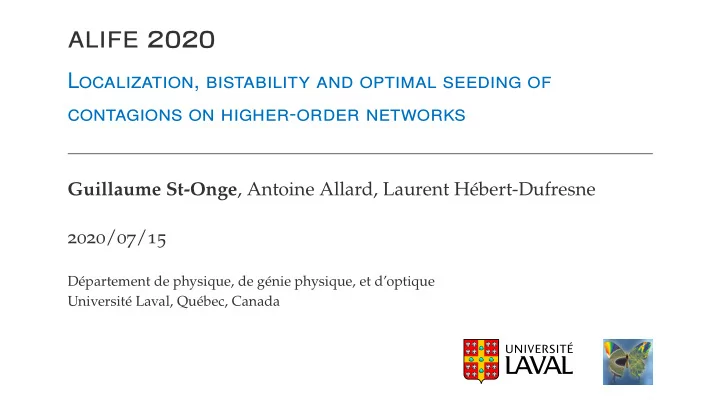

alife 2020 Localization, bistability and optimal seeding of contagions on higher-order networks Guillaume St-Onge , Antoine Allard, Laurent Hébert-Dufresne 2020/07/15 Département de physique, de génie physique, et d’optique Université Laval, Québec, Canada
Representations of complex systems No structure Network structure Higher-order networks Elements interact in pairs Basic elements have state Group of elements interacting � State : neuronal activity, political allegiance, species abundance � Pair interaction : synapse, friendship, predator-prey relationship � Group (higher-order) interaction : workplace environment, ecosystem 1
Contagion dynamics *Icons made by Freepik, catkuro, Smashicons and Pixel perfect from "www.flaticon.com" 2
Outline Goal of the presentation � Promote higher-order network (HON) representations of complex systems � Introduce an accurate method to describe stochastic dynamics on HONs Outline 1. Approximate master equations 2. Applications to contagion dynamics ◮ Localization of epidemics ◮ Bistability ◮ Optimal seeding 3
Approximate master equations 4
Mean-field equations for nodes Example d s m = 1 − s m − m r s m . d t Approximate master equations for groups d f n,i = ( i + 1) f n,i +1 − if n,i , d t � � − ( n − i ) β ( n, i ) + ρ f n,i , � � + ( n − i + 1) β ( n, i − 1) + ρ f n,i − 1 . � s m ( t ) : fraction of susceptible nodes with membership m � f n,i ( t ) : fraction of groups of size n with i infected β ( n, i ) : local infection rate � r ( t ) , ρ ( t ) : mean-field couplings � 5
Epidemic localization SIS model : β ( n, i ) = λi 6
Localization regimes Asymptotic analysis Finite cut-o ff s corrections � Group size distribution : p n ∼ n − γ n with cut-off n max � Membership distribution : g m ∼ m − γ m with cut-off m max = n max 7
Bistability emerges from nonlinear interactions Simple model of social contagion β ( n, i ) = λi ν � ν < 1 : inhibition effect � ν = 1 : SIS model � ν > 1 : reinforcement effect 8
Influence maximization Goal : Maximize ˙ I (0) by distributing wisely I (0) = ǫ ≪ 1 . Rules � We set λ > λ c so that I ∗ = 0 is unstable � You can choose among two approaches 1. Influential spreaders : engineer node set { s m (0) } 2. Influential groups : engineer group set { f n,i (0) } � The unchosen set is distributed randomly, i.e. � n � ǫ i (1 − ǫ ) n − i f n,i (0) = or s m = 1 − ǫ ∀ m . i 9
Influential spreaders Influential groups Optimal strategy Optimal strategy Infect nodes with highest Favor most profitable group confi- available membership m gurations ( n, i ) as measured from R ( n, i ) = β ( n, i )( n − i ) /i 10
Influential groups beat influential spreaders in nonlinear contagions Influential spreaders 0 . 05 I (0) Influential groups Initial spreading speed ˙ Random 0 . 04 0 . 03 0 . 02 0 . 01 0 . 00 − 0 . 01 1 . 0 1 . 5 2 . 0 2 . 5 3 . 0 Contagion non-linearity ν 11
What can higher-order network representations do for you? � New insights due to the focus on groups of elements � Analytical results to guide further exploration � The framework presented can be applied to various dynamical processes ◮ Voter models, evolutionary game theory, etc. d f n,i � � � � = ( i + 1) α ( n, i + 1) + ρ 1 α ( n, i ) + ρ 1 f n,i +1 − i f n,i , d t � � � � − ( n − i ) β ( n, i ) + ρ 2 f n,i + ( n − i + 1) β ( n, i − 1) + ρ 2 f n,i − 1 . 12
Aknowledgments Epidemic localization Vincent Thibeault, Antoine Allard, Louis J. Dubé, Laurent Hébert-Dufresne Preprints : arXiv:2004.10203 and arXiv:2003.05924 Bistability and optimal seeding Iacopo Iacopini, Giovanni Petri, Alain Barrat, Vito Latora, Laurent Hébert-Dufresne Funding and computational ressources 13
Recommend
More recommend